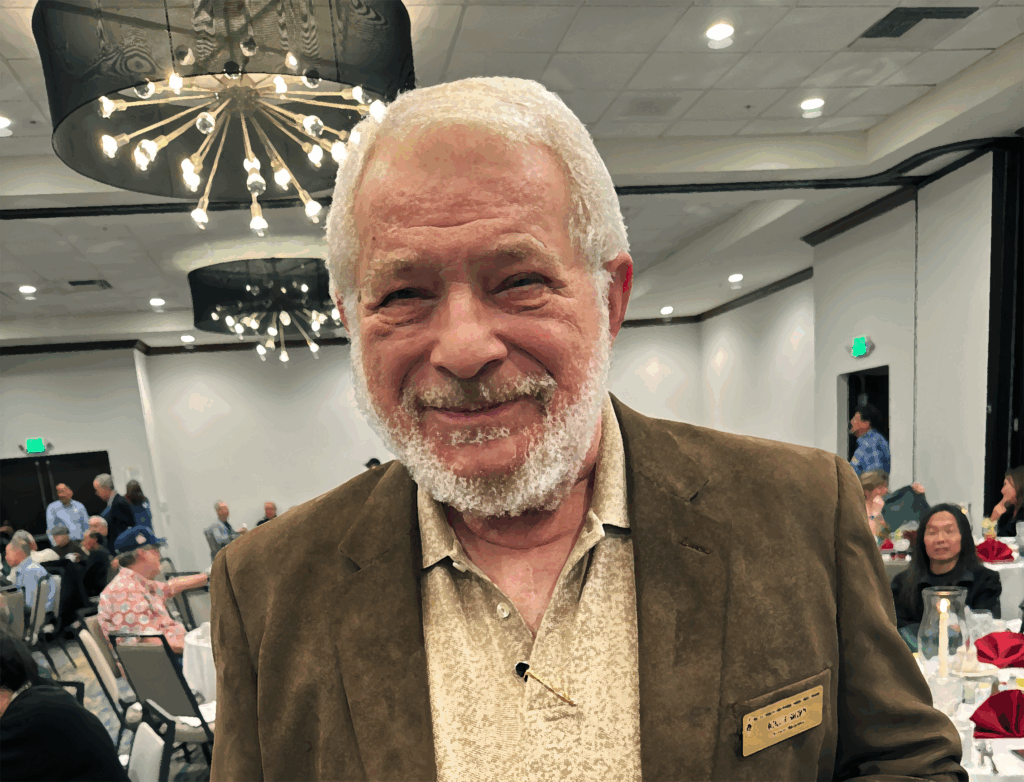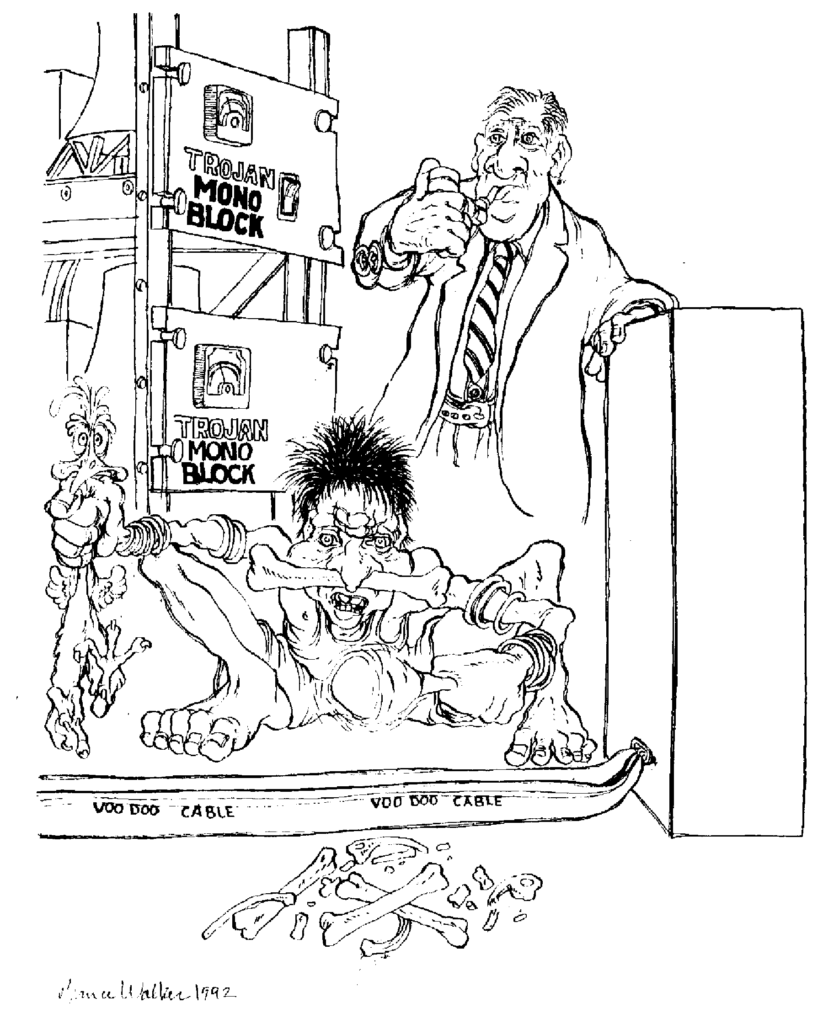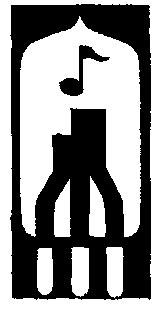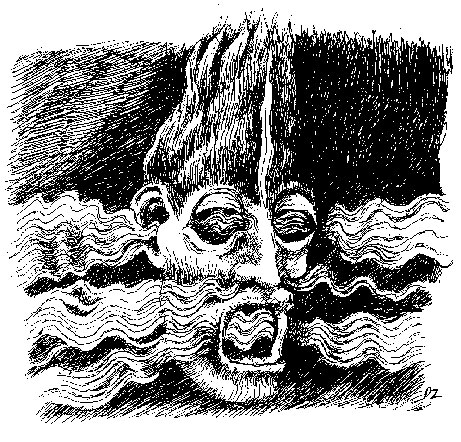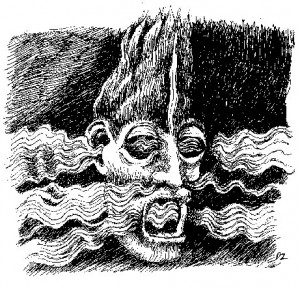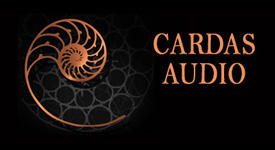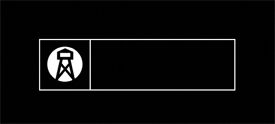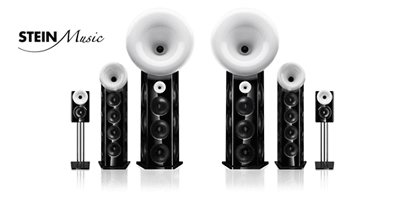Roger Skoff: a moment, Dry Brush Fantasy Variation. LAOC Gala 2024. (Photograph and image processing by David W. Robinson)
Roger Skoff writes the most radical article about High-End HiFi you'll ever read...
When I was a twelve year-old HiFi Crazy kid, back in the 1950s, HiFi was simple: There was only one (monophonic) channel. Stereophonic sound was still almost entirely unknown for home use, and the experts—people like Julian Hirsch, certainly the most prolific HiFi reviewer of the time—told us that the only elements of a HiFi system that really made an audible difference were its electromechanical components, the phono cartridge and the speaker.
The electronics, they said, all had broad enough, "flat" enough, frequency response curves (at least 50Hz-15kHz, +/- 3dB) and little enough (only about 1% or so), distortion so that any distortion that might still remain certainly couldn't be audible. And, as for anything else, the room was just the room, and whatever wire we might use was just wire, and obviously couldn't affect the sound.
In the nearly three quarters of a century since then, we've learned that those "experts" couldn't possibly have been more wrong: The effective frequency response range needed for good sound reproduction has been increased (more on this in another article); the amount of distortion allowable before we can hear it has been shown to be far less than what we originally believed; stereophonic sound has made the room, the placement of the speakers in it, and even the placement (time-alignment) of the individual drivers on the speakers' enclosures critical performance elements of the entire system; and—much to everyone's surprise—the system's wiring (interconnecting cables, phono cables, digital cables, speaker cables, and even AC power cords) have been shown to make a clearly audible difference to the system's sound.
Actually, that last shouldn't have been surprising at all: All of our HiFi systems rely on electricity for their operation at every stage, from the original recording through the movement of the diaphragms of the speakers' drivers that produces the sound, and there is nothing that can be done to any electrical signal—even including just passing the simplest DC signal through the shortest length of bare wire—that won't change the signal in some way, to some degree.
Yes, as you know, I am a cable designer and manufacturer, and having people learn more about, and want to buy more or better cables, could—at least if it's my brand that they want to buy—benefit me, but, regardless of that or of anything else, or of how many people start screaming "Voodoo" or "Snake Oil," physics is still physics, and the truth is still the truth.
And the fact is that, even just passing DC (far simpler than any music signal, which, by its nature, must be AC) through a bare wire (insulating the wire would add dielectric and electrostatic effects) will measurably affect the signal: Some portion of it—always be determined by the length, diameter, and material of the wire and by the voltage and current of the signal—will be converted to heat and lost forever.
Always. Without exception. Regardless of the signal or of the material of the conductor.
And that's only one way that a cable affects the signal it carries, and ultimately, the sound of your system.
Although there are many other factors to be considered in designing a cable for HiFi application, even the "measure-it-instead-of-listen-to-it" engineering types who tend to be the strongest cable naysayers agree that all cables have Resistance (R), Capacitance (C ), and Inductance (L), and that those things do make a difference.
Resistance is present in every conductor, and is simply a measurement of the conductive material's opposition to the flow of electric current. The only thing that affects it is the amount (length and total effective diameter) of that material used to conduct the signal.
In order for a cable to function as a cable, though, it needs to have not just one, but two separate conductors; one for the carried signal to go forward through, from the signal's source to its load (the signal's destination), and another for the signal, once carried, to return from the load back to its source. This completes the signal's "circuit," and unless the circuit is complete (not "open," meaning that the signal is blocked [as by a switch] from running its full path, or "short," meaning that the two conductors are touching each other somewhere between source and load,) no signal can flow.
It's only once a circuit is created—meaning that both "legs" of the cable/circuit are present—that those other two electrical characteristics, capacitance and inductance, are created, and they work inversely—in a "seesaw" relationship to each other, regardless of the materials of the conductors: The less distance there is between the two conductors, the more capacitance (C) there will be, and the less inductance. And, conversely, the farther apart they are, the greater the inductance (L) and the lower the capacitance (C).
So, what do we have here? A situation where nothing at all can be done to an electrical signal without changing it—even if it's just a DC signal and one short wire.
Except that you can't pass a signal without a path available to return it to its source. That means that the one wire example is impossible, and just one wire, by itself, can't work: There has to be two of them (or at least two conductive paths) to make a circuit. And, just as even a single uninsulated wire will lose some of the signal energy as heat because of resistance, the minute you add that second wire, you all-of-a-sudden pick up two more significant electrical characteristics—capacitance and inductance—both of which involve the ability to store and release energy, and both of which make changes of their own to the signal, although of different kinds.
Here's something else to consider: If capacitance and inductance are introduced when the second wire is added and the amount of each is determined by the distance between the two wires, how do you suppose the distance gets there?
In cables, it's because either one or both of the wires has to be insulated (to keep them from touching and "shorting out") and it's the total thickness of the (one or two layers of) insulation between the actual conductors that defines the minimum distance between them. The maximum distance is set either because the wires are twisted together or because they have a shield or an outer jacket holding them together.
And that means that we've just added still another other significant factor to affect the sound: When any electrical current is run through any wire an electromagnetic field will be formed around the wire. That field is current-controlled and will continue for as long as current flows. When insulation is added to the wire, so is another field: a voltage-controlled electrostatic field that's formed around the insulation, and those two fields measurably interact to affect the signal flow.
The proof of this is found and easily measured by the insulated wire's velocity of propagation. (VoP) That's the actual speed of the passage of signal through the wire as a percentage of the speed of light.
If you take any two identical lengths of bare wire (two pieces of wire of the same length cut from the same spool, for example), and measure their velocity of propagation, you will get two identical readings. If, however, you were to take those same two lengths of wire and insulate them with different kinds of insulation (one with PVC, for example, and one with polyethylene) and measure them again, the results you'd get would be different: The two different kinds of insulation would cause the two wires to have two different velocities of propagation.
How can that be? Isn't the insulation just insulation—just something to block the unwanted flow of electrons? Sure, but Maxwell showed that the signal isn't carried by moving electrons, but, instead, by an electrical field around the conductor, and if that's the case and if there are at least two different fields present for an insulated conductor (electromagnetic and electrostatic) then the differences in VoP are easily explained as resulting from field interactions (which those who just believe in R,C, and L as determining factors never even consider).
And if it really is field interactions that cause the difference, and one field is current-controlled and the other is voltage-controlled, doesn't that mean that signals of different ratios of current to voltage (speaker cables = low voltage/high current; interconnects = relatively high voltage/very low current; phono cables = practically no voltage/practically no current) must have different field interactions? And doesn't it seem likely there should be just one optimum field ratio? And, if there is, then wouldn't cables for different purposes need to be constructed differently to accomplish the same field ratio?
Then, of course, there's the fact that different insulating materials (in cables or capacitors we call them dielectrics) have different dielectric constants. This means that, for the same cubic volume of material, different dielectrics will store and release different amounts of the signal energy passing through the cable or capacitor. This can affect the sound. Different dielectrics also have different amounts of dielectric absorption, meaning that, just as signal energy is lost as heat in passing through a wire, different dielectrics also lose energy as heat, and give back different amounts of the energy that they have stored. And they have different dump rates, meaning that some are faster than others in giving back stored energy. And…
No, this is not intended to be a dissertation on cable design. You don't need to know it and I have no desire to give away the benefit of years of research to my competitors. What it is intended to do is to show you that cables do make a difference, always to any signal in any system, and that that difference can't be avoided: There's nothing you can do to a signal that won't affect it.
On the other hand, although a cable will always do something to the signals it passes, unless you actually do some comparative listening (same system, same application, at least two different cables), there's no way to know what it's doing, how it affects your system's sound, or even that it's doing it.
For example, the theoretically as-perfect-as-you-can-get cable, while, like every other cable, making changes to the sound, would be so sonically neutral and do so little to the signal that you might be able to put it into and take it out of your system without ever hearing any difference at all. Or a different cable might make clearly and obviously audible sonic changes. It all depends on what the cable is changing; how it's changing it; and to what degree. And unless you know what the cable is doing, you have no way of knowing how it's affecting the sound of the system or component you're using it with.
It may be that the change effect, while definitely there, is so small as to not be audible. Or the change the cable makes might not be heard because it's in a portion of the music that's not there on the recording you're listening to; or it might be a change to something you never listen for. It might even be that, because of the sound of the rest of your system or your room acoustics that, even though it's there and you're listening for it, you still can't hear it.
It might also be that the difference is one you actually like because it adds to something in the music that you enjoy. Or it cancels out something in the music, in the recording, in your system or in your room that you don't like, and it improves the sound that way. In short, there's no cable that doesn't change the signal and affect the sound of your system, but the specific effects of specific cables vary, and what you hear from a cable in your system might add to your enjoyment, subtract from it, or not be noticeable at all.
Good! That means that you can use cables to your advantage.
And that finally gets us to the point of this article: All systems need cables; all cables make a sonic difference; not all cables make the same kind or degree of difference—they range all over the place. So, what should you do?
Listen!
When you audition speaker or electronic components at your dealer's, don't just ask to hear them. Ask to hear them with different cables in the system. Different speaker cables, different interconnects, different digital cables, a different phono cable (if you're doing analog), and, definitely different power cords. Your dealer may think you're a little nuts, but he'll also see that you're at least a potential cable customer, too, and he'll go along with what you ask.
The object is not just to get the best sound out of what you buy, but to see for yourself that all of those different kinds of cables—pieces of wire that you may have thought of as just pieces of wire—either do or don't make a different that you can hear.
If you can hear them, then you can use them to make your system better; if you can't, or if the differences are so minor that you simply don't care, good! Think of all the money you've just saved!
If you can hear the differences, though, whether you like or dislike the results, you're on the way to better sound. You may have to finally admit that cables are more than just bits of wire, but you'll be able either to discover the most neutral-sounding cables to allow those great other parts of your system to be heard in their full glory, unhindered by sonic changes you might never otherwise have even known were there. Or, if you know that a component is a little "bright," (for example) you can—if you're planning to keep that component for a while—use a cable that's a little "dark" to compensate for it.
Either approach—going for maximum neutrality or using cables to correct system flaws—works and can be used to your advantage.
The one thing that doesn't work is to think that pieces of wire are just pieces of wire, and that they all sound the same.
Drawings by Bruce Walker. Photographs and image processing by David W. Robinson.




